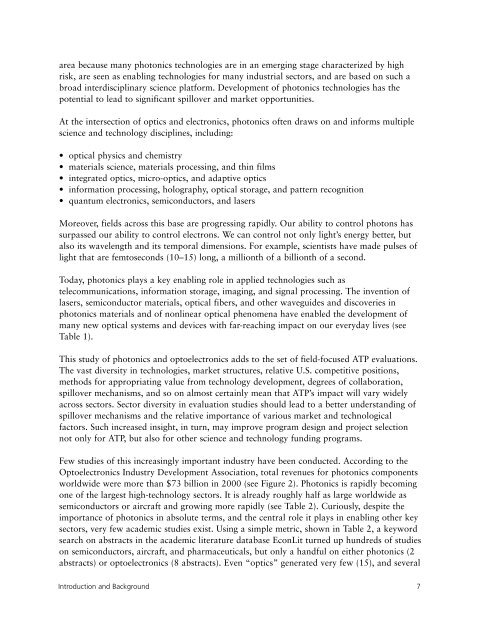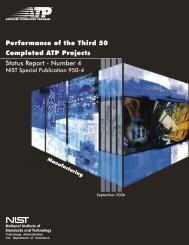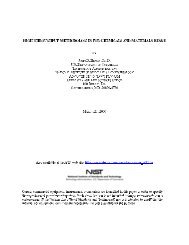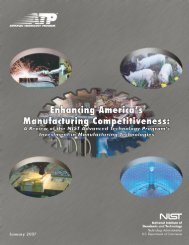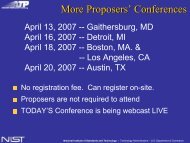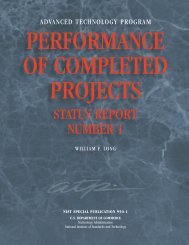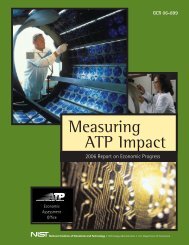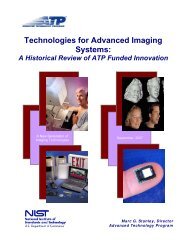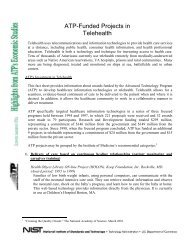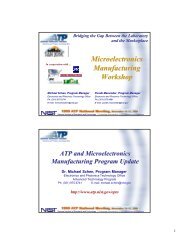Direct and Spillover Effects of ATP-Funded Photonics Technologies
Direct and Spillover Effects of ATP-Funded Photonics Technologies
Direct and Spillover Effects of ATP-Funded Photonics Technologies
- No tags were found...
Create successful ePaper yourself
Turn your PDF publications into a flip-book with our unique Google optimized e-Paper software.
area because many photonics technologies are in an emerging stage characterized by highrisk, are seen as enabling technologies for many industrial sectors, <strong>and</strong> are based on such abroad interdisciplinary science platform. Development <strong>of</strong> photonics technologies has thepotential to lead to significant spillover <strong>and</strong> market opportunities.At the intersection <strong>of</strong> optics <strong>and</strong> electronics, photonics <strong>of</strong>ten draws on <strong>and</strong> informs multiplescience <strong>and</strong> technology disciplines, including:• optical physics <strong>and</strong> chemistry• materials science, materials processing, <strong>and</strong> thin films• integrated optics, micro-optics, <strong>and</strong> adaptive optics• information processing, holography, optical storage, <strong>and</strong> pattern recognition• quantum electronics, semiconductors, <strong>and</strong> lasersMoreover, fields across this base are progressing rapidly. Our ability to control photons hassurpassed our ability to control electrons. We can control not only light’s energy better, butalso its wavelength <strong>and</strong> its temporal dimensions. For example, scientists have made pulses <strong>of</strong>light that are femtoseconds (10–15) long, a millionth <strong>of</strong> a billionth <strong>of</strong> a second.Today, photonics plays a key enabling role in applied technologies such astelecommunications, information storage, imaging, <strong>and</strong> signal processing. The invention <strong>of</strong>lasers, semiconductor materials, optical fibers, <strong>and</strong> other waveguides <strong>and</strong> discoveries inphotonics materials <strong>and</strong> <strong>of</strong> nonlinear optical phenomena have enabled the development <strong>of</strong>many new optical systems <strong>and</strong> devices with far-reaching impact on our everyday lives (seeTable 1).This study <strong>of</strong> photonics <strong>and</strong> optoelectronics adds to the set <strong>of</strong> field-focused <strong>ATP</strong> evaluations.The vast diversity in technologies, market structures, relative U.S. competitive positions,methods for appropriating value from technology development, degrees <strong>of</strong> collaboration,spillover mechanisms, <strong>and</strong> so on almost certainly mean that <strong>ATP</strong>’s impact will vary widelyacross sectors. Sector diversity in evaluation studies should lead to a better underst<strong>and</strong>ing <strong>of</strong>spillover mechanisms <strong>and</strong> the relative importance <strong>of</strong> various market <strong>and</strong> technologicalfactors. Such increased insight, in turn, may improve program design <strong>and</strong> project selectionnot only for <strong>ATP</strong>, but also for other science <strong>and</strong> technology funding programs.Few studies <strong>of</strong> this increasingly important industry have been conducted. According to theOptoelectronics Industry Development Association, total revenues for photonics componentsworldwide were more than $73 billion in 2000 (see Figure 2). <strong>Photonics</strong> is rapidly becomingone <strong>of</strong> the largest high-technology sectors. It is already roughly half as large worldwide assemiconductors or aircraft <strong>and</strong> growing more rapidly (see Table 2). Curiously, despite theimportance <strong>of</strong> photonics in absolute terms, <strong>and</strong> the central role it plays in enabling other keysectors, very few academic studies exist. Using a simple metric, shown in Table 2, a keywordsearch on abstracts in the academic literature database EconLit turned up hundreds <strong>of</strong> studieson semiconductors, aircraft, <strong>and</strong> pharmaceuticals, but only a h<strong>and</strong>ful on either photonics (2abstracts) or optoelectronics (8 abstracts). Even “optics” generated very few (15), <strong>and</strong> severalIntroduction <strong>and</strong> Background 7


